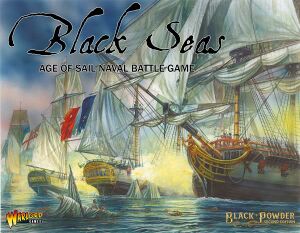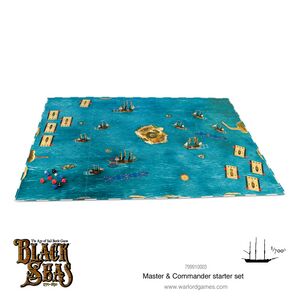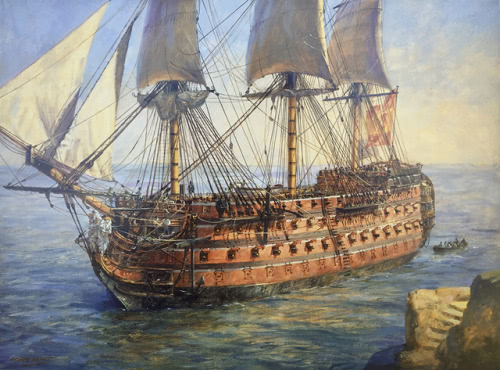Black Seas

"Do you not know that in the service … one must always choose the lesser of two weevils?"
- – John "Lucky Jack" Aubrey
"Stop blowing holes in my ship!"
- – Captain Jack Sparrow
Released in October of 2019, Black Seas is a squadron-scale, Age-of-Sail tabletop wargame produced by the venerable Warlord Games. The system's release was accompanied by several swanky, 1/700 scale models that typically come in boxes with multiple models per pack, at astonishingly affordable prices considering how many you need to play a full 2,000 point game.
Black Seas's lead designer is possibly the only Italian who has ever contributed to the economy. Gabrio Tolentino might be a recognizable name to anyone with copies of Cruel Seas or Pirates of Nassau on their shelf.
Ye be warned: you're about to become much more acquainted with naval terminology than you're comfortable with.
YARRRRR
Gabrio states pretty plainly what his design philosophy was when writing the system down right at the start of the rulebook on page 3; "These rules are designed for a fast-paced and fun game, rather than to give a completely authentic sailing simulation. They're realistic in many respects, but several of the intricacies and difficulties of battling with a fully rigged sailing ship have been simplified to avoid games becoming bogged down in unnecessary minutiae and book keeping."
Boy, does he deliver. Weighing in at a respectable, yet not overwhelming 95 pages, the Black Seas rulebook is an approachable system for players looking for an excuse to blast sea shanties during their game night. The main rulebook contains all you need to play the game, including faction rules, ship points and profiles, upgrades and their costs, as well as, well, the rules. Players coming from the world of Games Workshop will breath a sigh of relief for not needing to carry a library with them to game night if this is on the menu.
One praiseworthy aspect of the rulebook is that it essentially contains two "halves;" a simplified set of rules in the first half, and the full, "advanced" rules in the latter portion of the text. Players can therefore choose how in-depth they'd like to get with their game, such using the basic or advanced wind gauge (discussed later). This can cut down on play time significantly in bigger games where more than a dozen ships are maneuvering and blasting away at each other. The book also contains several scenarios, ranging from an imitation duel based on the opening engagement from Master and Commander, to a to-scale scale recreation of the Battle of Trafalgar (1805) which requires more than forty ships, and an 8x6 foot table!
Core Mechanics

Black Seas uses a handful of simple mechanisms that are integral to the game's function.
Weather Gauge: This determines three very important aspects of the game; who goes first, where the wind comes from, and how fast a particular ship can go depending on its heading. Simply put, the "wind" necessary to fill our sails always comes in from a table edge, and the ship closest to the wind's source activates first, no matter who controls it or went last. Once that ship has finished, the next closest ship goes, and so on. However, players roll at the beginning of each turn to see if the wind changes direction, effectively giving a chance for a new part of the table edge to be the wind source. Therefore, you can never be entirely certain what ship will go first. The weather gauge widget included in the aptly named Master and Commander starter set is used to record these details. Finally, depending on how the wind hits a ship, it might be possible for the vessel to use its top speed, or come to an abrupt stop if the wind is against it. In the event of the latter, there is real potential to damage your ship as the masts take a beating.
Sails: The amount of sails deployed by a ship determines its speed (duh). The more sails, the faster she goes. Ships can move up or down by one level per turn. There are four levels of sails; anchored, light sails, battle sails, and full sails. Each higher level of sails allows an additional move. As an example, a ship with light sails moves once, while one with battle sails moves twice. Some ships can only use certain levels, while others are restricted. For example, First Rate ships can never use full sails because they're simply too massive to move that fast in a combat situation when its crew is otherwise occupied, not to mention how dangerous a huge wooden behemoth filled with highly explosive powder and more than 3,500 tons of displacement going full-tilt in a crowded battlefield is.
Rate of Knots: Depending on the type and size, ships are assigned a Rate of Knots (typically from 3 to 6), higher numbers being faster. This value gets translated directly to inches of movement. This ties back into the level of sails. Using our prior example on a ship with a Rate of Knots of 5, if we assume it is using battle sails, it will move 10 inches. Meanwhile, if it goes to light sails, it will move 5 inches.
Turning: Ships turn either 35 or 45 degrees depending on their size at the end of every turn to a maximum of three turns per activation. Some ships, such as First Rates, can only do two per activation. Bear in mind that a ship *must* move more than once to get those extra turns, so remember to have battle sails on if you want to make that wide turn!
Ship Mechanics
Ships are condensed into five main subgroups. In ascending order of size:
- Tiny: sloops, cutters, gun yawls, things that you can sink by driving your car or moped into it at relatively low speeds.
- Small: Brigs, schooners, small galleys, xebecs, basically the boats you wouldn't want to be on if anything heavier than a watermelon gets thrown your way.
- Medium: Frigates, smaller merchant ships, and built-up ships like oversized galleys. These are the backbone of most fleets, as they're capable of both dishing and taking respectable punishment while also maintaining maneuverability.
- Large: 3rd Rates, US Navy "super frigates" from the late 18th century, and other things that compensate for lacking manhood.
- Extra Large: The only examples of these are the real thing. First Rate ships like the HMS Victory, L'Orient, or even Nuestra Señora de la Santísima Trinidad fit in this category. As is befitting their obscene excess, these ships are prohibitively expensive and bringing even *one* can anywhere from a quarter to half of your budget, depending on the agreed point ceiling.
